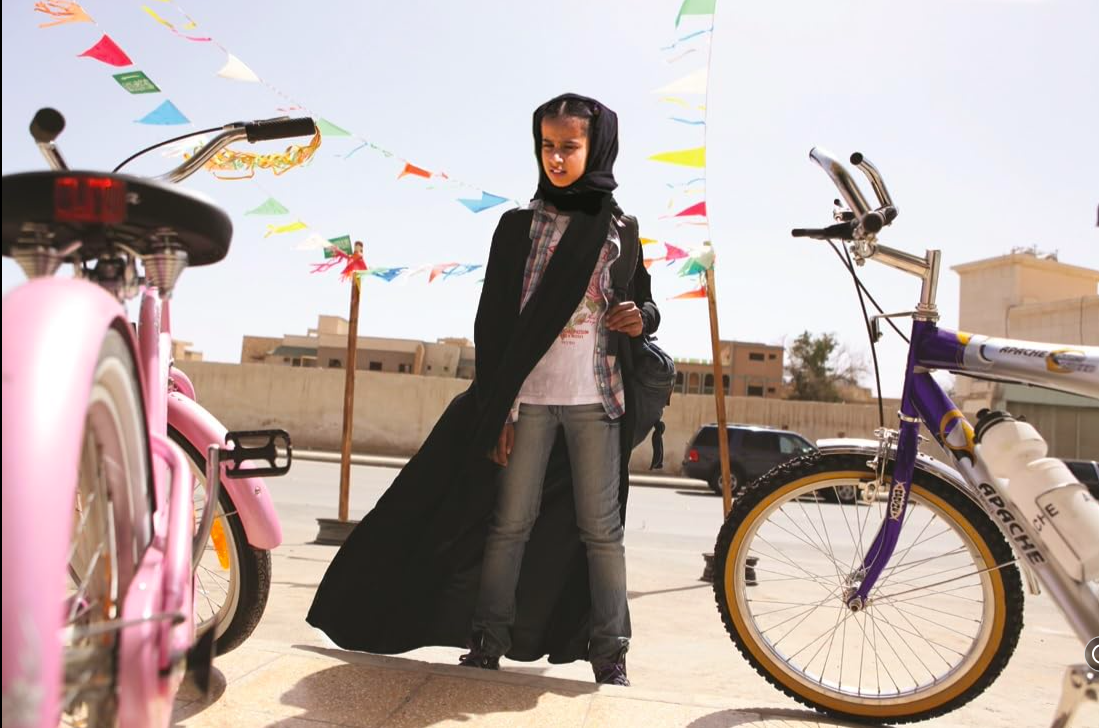OTC Rating : 4.5/5
Introduction
Haifaa Al-Mansour’s Wadjda (2012) is a groundbreaking Saudi Arabian film that tells a simple yet powerful story of a young girl’s dream of owning a bicycle in a society where such ambitions are frowned upon. Streaming on MUBI, Wadjda is not only a cinematic milestone as the first feature film shot entirely in Saudi Arabia by a female director but also a deeply human and inspiring narrative. With its naturalistic storytelling, restrained yet effective direction, and a compelling lead performance, the film beautifully balances social commentary with personal storytelling.
Story & Narrative Structure
The film follows Wadjda (Waad Mohammed), a spirited 10-year-old girl living in Riyadh, who dreams of owning a bicycle so she can race against her friend Abdullah. However, her aspirations conflict with the societal expectations placed upon young girls in her conservative environment. Determined, she enters a Quran recitation competition at school, hoping to use the prize money to buy the bicycle.
Al-Mansour structures the narrative in a straightforward yet emotionally resonant manner. The film subtly critiques gender restrictions without overt confrontation, instead letting Wadjda’s personal struggle speak for itself. The story is both intimate and universal, making it accessible to audiences worldwide.
Image credit : IMDB
Direction & Cinematography
Haifaa Al-Mansour directs with an observational, neorealistic style, capturing the everyday life of women in Saudi Arabia with nuance and authenticity. She employs a restrained, yet deeply effective approach, avoiding melodrama and allowing the characters to exist naturally within their environment. Her direction makes even the smallest moments, such as Wadjda adjusting her sneakers or peeking at boys riding bikes, feel significant.
Cinematographer Lutz Reitemeier’s work gives the film a quiet, understated beauty. The visuals are mostly grounded, with a muted color palette reflecting the limitations of Wadjda’s world. However, the camera also subtly shifts to highlight moments of hope and resilience, particularly in the contrast between the confined spaces of Wadjda’s home and school and the open streets where she dreams of riding her bike.
Performances
Waad Mohammed as Wadjda delivers a remarkably natural and heartfelt performance. She embodies the character with a perfect mix of defiance, charm, and innocence, making her instantly relatable and likable. Her expressive face conveys her emotions effortlessly, whether it’s frustration at societal restrictions or the joy of defying them in small ways.
Reem Abdullah, playing Wadjda’s mother, gives a nuanced performance as a woman torn between personal struggles and societal expectations. Her relationship with Wadjda adds depth to the film, showing how generations of women navigate the limitations imposed on them differently.
Supporting performances, including Abdullrahman Al Gohani as Abdullah and Ahd as the strict school principal, add further layers to the story, reinforcing the world Wadjda must navigate.
Image credit : IMDB
Production & Art Design
The film’s production design is deliberately minimalistic, reflecting the realism of its setting. The domestic interiors, the strict and muted school environment, and the dusty streets of Riyadh all contribute to an authentic depiction of everyday life in Saudi Arabia. The contrast between Wadjda’s playful, colorful spirit and the rigid, controlled spaces she inhabits visually reinforces the film’s central conflict.
Costumes also play a significant role in storytelling. Wadjda’s preference for sneakers and jeans over traditional attire symbolizes her resistance to conformity, while the black abayas and headscarves worn by women around her reinforce the societal expectations placed upon them.
Sound Design & Music
The film’s sound design is subtle yet effective. Everyday ambient sounds—like the call to prayer, school bells, and traffic—help ground the film in realism. Silence is also used effectively, making Wadjda’s moments of quiet defiance even more impactful.
The music in Wadjda is sparse but meaningful. The score by Max Richter is delicate and emotional, enhancing the film’s introspective moments. However, much of the film relies on diegetic sound, reinforcing its naturalistic tone. Wadjda’s own interactions with music, such as listening to pop songs on the radio, serve as small acts of rebellion and self-expression.
Image credit : IMDB
Editing
Andreas Wodraschke’s editing ensures a steady yet engaging pace. The film never feels rushed, allowing scenes to breathe and characters to develop naturally. The transitions between Wadjda’s home, school, and the streets are smooth, reinforcing the structure of her world and her small yet significant acts of resistance within it.
The film also benefits from a restrained approach to cutting, avoiding unnecessary dramatic flourishes. This allows the emotional beats to land organically, making Wadjda’s journey feel even more authentic and affecting.
Final Verdict
Wadjda is a groundbreaking and deeply moving film that transcends cultural boundaries with its universal themes of freedom, resilience, and hope. Haifaa Al-Mansour’s direction, combined with naturalistic performances and a well-crafted visual and soundscape, makes it a must-watch. It is a rare and precious film that not only tells an engaging story but also serves as a quiet revolution in itself.
Why Watch It
- A historic first in Saudi Arabian cinema, directed by a female filmmaker.
- A beautifully simple yet deeply powerful story of a girl challenging societal norms.
- An outstanding lead performance by Waad Mohammed.
- A visually authentic and emotionally resonant cinematic experience.

